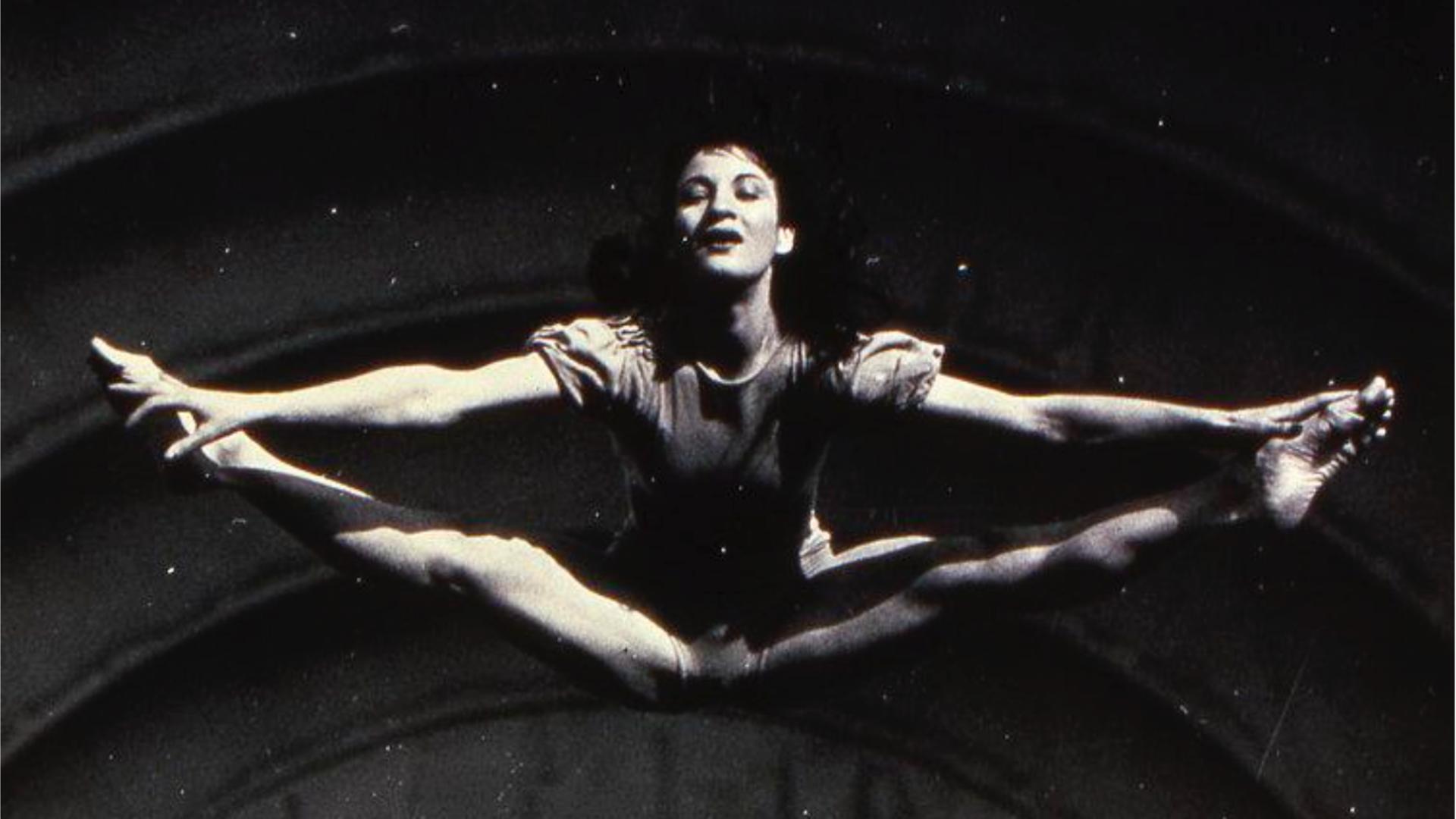
This is the story of a strong, talented, out-spoken artist, who gave her creative life to protect the rights of every American citizen. Born while her parents were members of the socialist Llano Del Rio Colony in 1916, raised on a chicken farm in Highland, Lewitzky became the star of the Lester Horton Dance Group, the first American inter-racial dance company. Based in Los Angeles in the 1930’s and 40’s she was the primary developer of the Horton technique. Her students included Alvin Ailey and Carmen De Lavallade who went on to form the Alvin Ailey company in New York. The Horton technique is taught world-wide, and unlike modern techniques developed in the eastern United States, is based on Native American dance. In Lewitzky, Horton found the body upon which he would build his technique, a uniquely west coast modern dance.
Lewitzky’s move to the Los Angeles in 1930 from San Bernadino with her family exposed her to a new kind of intensity. She lived in a diverse, working-class neighborhood at the height of the depression. As the lead dancer of the Horton Company, Lewitzky starred in his productions of “Salome” and “Rite of Spring” at the Hollywood Bowl in 1937 to rave reviews. Her work in “Tierray libertad,” a comment on the Spanish conquest of Mexico, and “Departure From The Land,” an evocation of Dust Bowl emigration, drew cheers at the end of each performance. Social injustice, anti-fascism, American and Mexican history were some of the themes of Horton’s dances embodied by dancers committed to these themes in their daily lives. They did not shrink from such topics as police brutality toward Mexican-Americans in such works as “The Park.” Being a modern dancer in Los Angeles at this time did not provide a sustainable income. To support herself and her family Lewitzky worked under the Federal Theatre Project in works choreographed by Horton and others. She also assisted Horton on film projects as well as Hanya Holm and Agnes DeMille.
In 1950 Lewitzky and Horton parted ways. Lewitzky felt a need to develop her own choreographies and ultimately opened a small studio, Dance Associates, on the other side of Hollywood. She recalls, “... one day a gentleman with a hat on... handed me a subpoena.” She was called to testify before the House Un-American Activities Committee where she pleaded the Fifth Amendment. Her life took a drastic turn following these events. She later stated, “It really is frightening when you can realize that your safety and right to life can be removed from you and that your enemy is never seen, is hidden, and that your accusers cannot be confronted because you don’t know who they are.” (Lewitzky’s FBI file was recently released, albeit blacked out excessively.) Film work was impossible for her. The only person who would hire her was Agnes DeMille, choreographer for the film adaptation of Oklahoma. Lewitzky recalls,” ... Her usual assistants were not available to her, and she asked if I would be interested in dong it. I pointed out to her that I was at that point quite publicly blacklisted. Agnes had courage. She said, ‘It’s all right.’” Although she was the rehearsal director, assisted DeMille in re-choreographing scenes, and danced in some scenes, the studio stipulated that she would not receive credit for her work. Lewitzky did not work professionally for ten years, although she continued to choreograph and teach on her own.
In 1966 she founded the Bella Lewitzky Dance Company. Unlike her earlier works, which were dramatic and socially conscious, her new choreography emphasized pure movement, and her dancers became noted for their strength, line, elevation, and agility—a tribute to her gifts as a teacher. She also became the founding dean of the School of Dance at the California Institute of the Arts where she developed a multicultural/inter-arts approach to teaching modern dance. She worked tirelessly to promote dance in California and sat on many national panels and boards.
In 1990 Lewitzky refused to sign an anti-obscenity clause on the acceptance form of a $72,000 National Endowment for the Arts grant. Unable to meet their payroll, her company disbanded as she joined with People for the American Way to sue the NEA. Calling a press conference at the Roosevelt Hotel in Hollywood, site of the 1950’s HUAC hearings, she stated, “Please watch out. This is a pattern with which I am very familiar and it has nothing to do with pornography. Pornography is simply the demagogic weapon that permitted mind rule and censorship to move forward.” Lewitzky prevailed in this landmark case and was finally awarded the grant. The NEA was instructed to “take into consideration general standards of decency and respect for the diverse beliefs and values of the American public.” This process took time away from Lewitzky’s choreography and fund raising.
After a re-organization she decided to close her company with a final international tour and gala. On May 17, 1997 at the Luckman Theatre at Cal State LA, the campus where her company gave its first performance, she said good-bye to her audience and stated, “The arts are under threat more than ever before. What legacy I have left here will die unless you become responsible for keeping it alive.”
Bella Lewitzky died on July 16, 2004. At age 88, her physical health had deteriorated but her vital spirit continued to inspire those around her. Designated one of America's Irreplaceable Dance Treasures by the Dance Heritage Coalition and awarded the National Medal of Arts by President Clinton, Lewitzky’s life demonstrates how an artist with vision and tenacity changed the lives of her fellow citizens for the better.

This is the story of a strong, talented, out-spoken artist, who gave her creative life to protect the rights of every American citizen. Born while her parents were members of the socialist Llano Del Rio Colony in 1916, raised on a chicken farm in Highland, Lewitzky became the star of the Lester Horton Dance Group, the first American inter-racial dance company. Based in Los Angeles in the 1930’s and 40’s she was the primary developer of the Horton technique. Her students included Alvin Ailey and Carmen De Lavallade who went on to form the Alvin Ailey company in New York. The Horton technique is taught world-wide, and unlike modern techniques developed in the eastern United States, is based on Native American dance. In Lewitzky, Horton found the body upon which he would build his technique, a uniquely west coast modern dance.
Lewitzky’s move to the Los Angeles in 1930 from San Bernadino with her family exposed her to a new kind of intensity. She lived in a diverse, working-class neighborhood at the height of the depression. As the lead dancer of the Horton Company, Lewitzky starred in his productions of “Salome” and “Rite of Spring” at the Hollywood Bowl in 1937 to rave reviews. Her work in “Tierray libertad,” a comment on the Spanish conquest of Mexico, and “Departure From The Land,” an evocation of Dust Bowl emigration, drew cheers at the end of each performance. Social injustice, anti-fascism, American and Mexican history were some of the themes of Horton’s dances embodied by dancers committed to these themes in their daily lives. They did not shrink from such topics as police brutality toward Mexican-Americans in such works as “The Park.” Being a modern dancer in Los Angeles at this time did not provide a sustainable income. To support herself and her family Lewitzky worked under the Federal Theatre Project in works choreographed by Horton and others. She also assisted Horton on film projects as well as Hanya Holm and Agnes DeMille.
In 1950 Lewitzky and Horton parted ways. Lewitzky felt a need to develop her own choreographies and ultimately opened a small studio, Dance Associates, on the other side of Hollywood. She recalls, “... one day a gentleman with a hat on... handed me a subpoena.” She was called to testify before the House Un-American Activities Committee where she pleaded the Fifth Amendment. Her life took a drastic turn following these events. She later stated, “It really is frightening when you can realize that your safety and right to life can be removed from you and that your enemy is never seen, is hidden, and that your accusers cannot be confronted because you don’t know who they are.” (Lewitzky’s FBI file was recently released, albeit blacked out excessively.) Film work was impossible for her. The only person who would hire her was Agnes DeMille, choreographer for the film adaptation of Oklahoma. Lewitzky recalls,” ... Her usual assistants were not available to her, and she asked if I would be interested in dong it. I pointed out to her that I was at that point quite publicly blacklisted. Agnes had courage. She said, ‘It’s all right.’” Although she was the rehearsal director, assisted DeMille in re-choreographing scenes, and danced in some scenes, the studio stipulated that she would not receive credit for her work. Lewitzky did not work professionally for ten years, although she continued to choreograph and teach on her own.
In 1966 she founded the Bella Lewitzky Dance Company. Unlike her earlier works, which were dramatic and socially conscious, her new choreography emphasized pure movement, and her dancers became noted for their strength, line, elevation, and agility—a tribute to her gifts as a teacher. She also became the founding dean of the School of Dance at the California Institute of the Arts where she developed a multicultural/inter-arts approach to teaching modern dance. She worked tirelessly to promote dance in California and sat on many national panels and boards.
In 1990 Lewitzky refused to sign an anti-obscenity clause on the acceptance form of a $72,000 National Endowment for the Arts grant. Unable to meet their payroll, her company disbanded as she joined with People for the American Way to sue the NEA. Calling a press conference at the Roosevelt Hotel in Hollywood, site of the 1950’s HUAC hearings, she stated, “Please watch out. This is a pattern with which I am very familiar and it has nothing to do with pornography. Pornography is simply the demagogic weapon that permitted mind rule and censorship to move forward.” Lewitzky prevailed in this landmark case and was finally awarded the grant. The NEA was instructed to “take into consideration general standards of decency and respect for the diverse beliefs and values of the American public.” This process took time away from Lewitzky’s choreography and fund raising.
After a re-organization she decided to close her company with a final international tour and gala. On May 17, 1997 at the Luckman Theatre at Cal State LA, the campus where her company gave its first performance, she said good-bye to her audience and stated, “The arts are under threat more than ever before. What legacy I have left here will die unless you become responsible for keeping it alive.”
Bella Lewitzky died on July 16, 2004. At age 88, her physical health had deteriorated but her vital spirit continued to inspire those around her. Designated one of America's Irreplaceable Dance Treasures by the Dance Heritage Coalition and awarded the National Medal of Arts by President Clinton, Lewitzky’s life demonstrates how an artist with vision and tenacity changed the lives of her fellow citizens for the better.